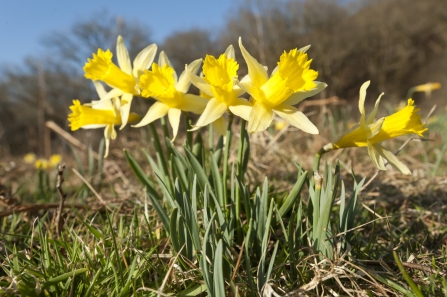Daffodil, Narcissus pseudonarcissus, Cenhinen Pedr, Daffydowndilly, Cenhinen aur, Lent lily ... It doesn’t matter what you call it, this yellow flower is a welcome sight at the end of winter.
Everyone is familiar with the cultivated varieties which adorn our gardens and public spaces but far fewer of us know of the native species from which the cultivars were bred. True wild daffodils are less showy than the garden varieties – and smaller, too. The petals are thin, papery and paler than the trumpet, whilst the leaves are a greyish green. Where they grow, however, they are often quite spectacular as they crowd together in colourful drifts.
The distribution of wild daffodils in our part of the country is very patchy but, fortunately, North Wales Wildlife Trust has a colony on one of its oldest reserves, Coed Cilygroeslwyd, just south of Ruthin. This ancient woodland was purchased from the local council in the 1960s for the nominal fee of £1 and in the spring it is full of wild flowers and birdsong, a wonderful experience for young and old alike.
Once on the reserve, follow the lane in front of you until you reach a kissing gate at the top edge of the wood. Turn right here along the perimeter path and in about 200 meters you will reach the daffodils. (If you continue to follow the perimeter path it will lead you back to the reserve entrance.) Along the way, you should encounter many other wild flowers including primrose, wood anemone and violets.

